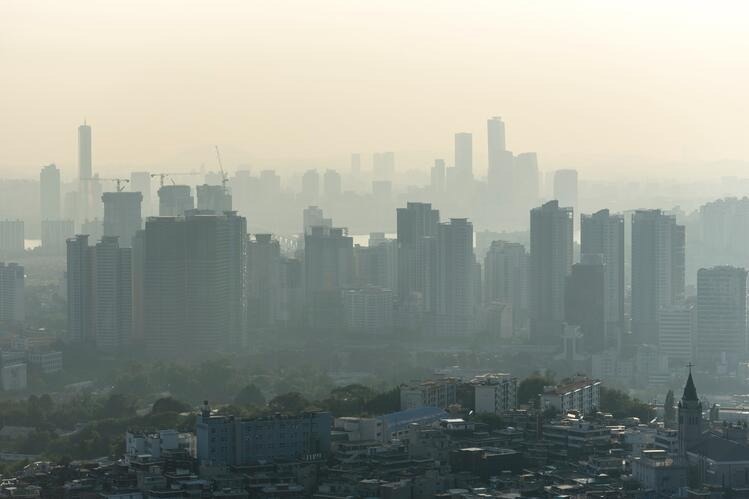Industrial activity produces carbon monoxide emissions, which are a powerful indication of total air pollution levels and significantly affect people. While many nations strive to lower their emissions, they have no control over air flows that originate in other areas.

Air pollution over Seoul, South Korea Image Credit: University of Illinois Urbana-Champaign
A recent study by researchers at the University of Illinois Urbana-Champaign examines the connections between global supply chain economic activities and air pollution fluxes worldwide.
Our study is unique in combining atmospheric transport of air pollution with supply chain analysis as it tells us where the pollution is coming from and who is ultimately responsible for it.
Sandy Dall’erba, Professor and Study Lead Author, Department of Agricultural and Consumer Economics, University of Illinois Urbana-Champaign
Sandy Dall’erb is also a Director of the Center for Climate, Regional, Environmental and Trade Economics (CREATE), both part of Illinois's College of Agricultural, Consumer and Environmental Sciences (ACES).
There is a direct link between a country’s level of production and how much air pollution is emitted. But production may be driven by demand from consumers in other countries. We use supply chain analysis to quantify the links between production and consumption. This helps us to understand how production in one country is linked to domestic and foreign demand.
Sandy Dall’erba, Professor and Study Lead Author, Department of Agricultural and Consumer Economics, University of Illinois Urbana-Champaign
Using simulations created by Nicole Reiner, a Professor in the Department of Climate, Meteorology & Atmospheric Sciences in the College of Liberal Arts & Sciences at Illinois, the researchers followed the passage of pollutants through the atmosphere to comprehend the flow of emissions.
They separated the world into five categories for analytical purposes: Europe, China, South Korea, the United States, and the rest of the world. Located downwind of China, South Korea is a prime illustration of how pollution from a much larger upwind neighbor may impact a smaller nation.
Sandy Dall’erba said, “Over recent years, South Korea has taken several measures to reduce its own pollution, yet it has experienced worsening air quality. Why? The answer is to be found in its upwind neighbor, China. Yet, a large amount of the goods manufactured in China are destined for foreign consumers in the U.S. and in Europe, among other places. As such, who is to be blamed for the increase in air pollution in South Korea? That is the challenge we embarked on with this study.”
According to the research, carbon monoxide emissions from China to South Korea rose from 30 teragrams (Tg) in 1990 to 42 Tg in 2014.
Dall’erba explained, “To put these numbers in perspective, 5 Tg of carbon monoxide corresponds to the emissions from all of the cars in the U.S. – roughly 274 million – each driving 13,500 miles per year. So, it is definitely not a small increase. We conclude that South Korea has, in effect, lost control of their own air quality.”
Dall’erba and his colleagues conducted a structural decomposition analysis to pinpoint the economic drivers of carbon monoxide emissions in the five study regions. They discovered that although China’s technological advancements in pollution reduction have progressed, overall carbon monoxide emissions have increased due to its heightened production levels.
Subsequently, the researchers aimed to determine the source of demand that propels the increased production. In the case of China, while some of the growth can be traced to the US and European demand, it is predominantly driven by households within China itself. Dall'erba highlighted that the Chinese population experienced significant growth between 1990 and 2014, coupled with increased wealth, resulting in higher consumption levels.
Our findings show that pollution is a global concern that can’t be solved by individual countries. The world is connected, and we are all in this together, pollution in one country can result from economic activities in neighboring countries, which in turn is influenced by who is demanding the goods produced in that country. Pollution emitted anywhere in the world is going to have consequences all over the world to varying degrees.
Yilan Xu, Associate Professor and Study Co-Author, University of Illinois Urbana-Champaign
Dall'erba, Riemer, and Xu emphasize that everyone can contribute to reducing emissions. Manufacturers have the power to adapt technology, legislators have the power to enact laws or offer incentives, and customers have the power to select sustainable products.
The study received support from a seed grant from the Institute for Sustainability, Energy, and Environment (iSEE) in Illinois.
Journal Reference:
Dall’erba, S., et al. (2024) Identifying the key atmospheric and economic drivers of global carbon monoxide emission transfers. Economic Systems Research. doi.org/10.1080/09535314.2023.2300787.
Source: https://illinois.edu/